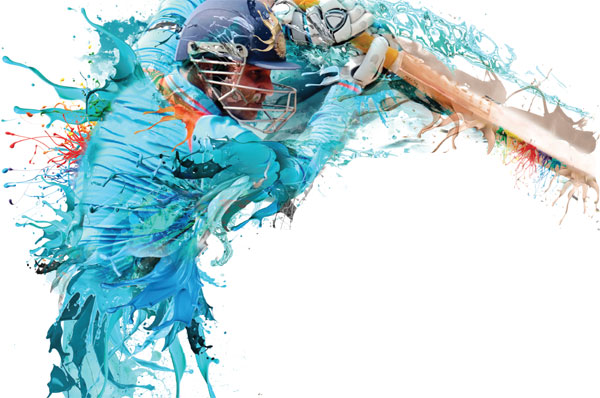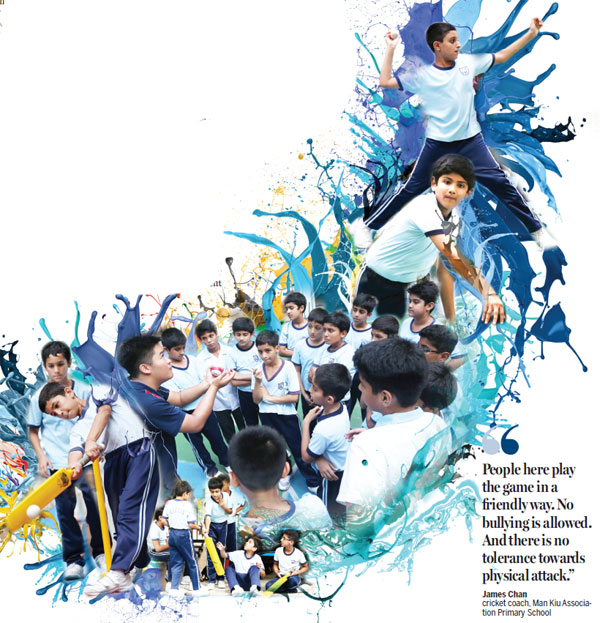Cricket without borders
Updated: 2015-06-15 09:32
By Wu Guanxiong(HK Edition)
|
|||||||
Young people from India and Pakistan - two nations with a history of communal and territorial conflicts - find a renewed spirit of kinship and camaraderie on the playing fields of HK. Wu Guanxiong reports.
Far from the lands of their ancestors, boys from India and Pakistan, two rival nations, are playing together in harmony, finding camaraderie and learning the spirit of sportsmanship on the "cricket grounds" of Hong Kong.
Trouble is, even as they gaze out across a typical pitch where the sport is played here, veteran players are sure to turn away in dismay, and declare "that's not cricket".
Take for example the 20 members of the Man Kiu Association Primary School cricket team. When it's time for them to hone their skills in the game introduced to the Indian subcontinent during the British colonial Era, the players meet on the basketball court.
The team comprises four boys of Indian origin and 16 whose forbearers came from Pakistan, all around 12 years old. The team has done pretty well, taking third place in the HKCA Primary Schools Playground League, then going on to win the championship in the Easy Sport Cricket Competition earlier this year.
Twelve is the age limit for kids to compete in the youngsters' cricket competition in Hong Kong. The boys of the Man Kiu Association Primary School team run and shout in all their exuberance, waiting for the bowler to make his delivery, while the batsmen get ready to send the ball to the far end of the pitch in the hope of scoring a run. The coach says they can hit the ball toward the teaching building and not the other way, toward the enclosure wall. Hitting the building results in a higher score but there's always the risk of breaking a window.
Evidently, the available facilities for playing cricket are pretty inadequate. Sports like football and basketball have a bigger following and attract government funding.
According to government statistics, while there were about 6,700 people training in government-subsidized programs promoting cricket in 2014-15, 62,300 trained in football, according to the Leisure and Cultural Services Department (LCSD). Some of the city's "cricket pitches" are also used for soccer games. Currently LCSD provides two designated venues for cricket training and matches, namely the natural turf pitch at Tin Kwong Road Recreation Ground and the artificial turf pitch at Po Kong Village Road Park, both of which are also used as football grounds. Some football pitches have also been made available for cricket because of the growing demand. The LCSD has designated nine hard-surface pitches to play "tape-ball" cricket.
Like all competitive sports, cricket is a character-building exercise. As the Duke of Wellington supposedly said, "The Battle of Waterloo was won on the playing fields of Eton".
Dialogue helps
The successful cooperation between the Indian and Pakistani boys on the cricket field is evident in the trophies lining the school's hallway.
"Cricket is a funny, old game," said James Chan, the team's coach, who started coaching the team a few weeks ago, and is still getting to know the kids. "It has its social nature."
Standing at the edge of the field where the boys were practicing, Chan took special note of the teamwork required. In cricket games, one cannot depend on the star batsman or bowler in the team to constantly win matches. The bowler tries to hit the wicket, while the fielders try to catch the batted ball.
On the edge of the pitch stood Gurvir Singh Sandhu, 13, from India, leaning forward, all set to catch the ball once it's struck by a batsman.
Sandhu is one of the more popular players in the team, says Andrew Wan, the school's physical education instructor.
"Sandhu is popular because he plays cricket well and other kids like him," said Wan.
Off the field, Sandhu offered his own version. "I'm popular because I'm a good friend. They are kind to me. I'm also kind to them." In the beginning he was quite shy, he said, but his parents told him to make the effort and reach out to colleagues. Today he counts at least 20 Pakistanis among his large group of friends.
Once the game's over, the boys usually go out for snacks. "We also went to Disneyland," says Sandhu.
One of his friends, Danyal Ahmed, of Pakistani origin, elbows his way through the cluster of curious students, sidling up to Sandhu. "I'm his best friend," Ahmed declares, revealing that the friendship has seen a few odd fights in its wake.
Asked how they solved the problems between them, Ahmed paused for a second. "We talked it over," he said.
There are no girls on the team. "We played cricket with the boys when we were younger. But as we got older, the boys said we weren't fast enough," said Rajvir Kaur, an Indian girl, who sat watching her brother practicing on the pitch.
Two Pakistani girls, whose brothers were also out on the field, kept her company. They'd all walk back home together, once the practice was over. There are about 450 students at the school, including about 150 Pakistanis and 50 Indians, says Andrew Wan.
Distanced from conflicts
The 2011 census stated that there were 18,043 residents of Pakistani descent and 28,616 residents of Indian origin in Hong Kong, accounting for 0.26 percent and 0.4 percent of the total Hong Kong population respectively. Young people seem unaffected by the history of tension between the countries of their origin.
"Most of them were born in Hong Kong. Their parents know about the conflicts, but they don't," said Wan. Their source of information is history lessons learnt at school and on the Internet.
Since the partition of India in 1947 and the birth of Pakistan, the two countries have had to deal with communal issues and territorial disputes. The majority of Indians are Hindu by faith, whereas the state religion of Pakistan is Islam, practiced by 95 to 98 percent of the nation's population. Both countries lay claim to the Jammu-Kashmir regions.
"I'm Sikh," says Sandhu. He confesses his ignorance about the religious beliefs held by the people of Pakistan. Sandhu's best friend Ahmed does not seem to know much about Islam either. "I never asked my father," said Ahmed.
Like China's table tennis diplomacy, which has helped build warmer ties around the world, the mutual love of cricket has long served as a cementing factor between India and Pakistan, at least when the players are outside of their respective territories.
More than a quarter century ago, Pakistan's president visited India to watch cricket matches.
"People here play the game in a friendly way. No bullying is allowed. And there is no tolerance towards physical attack," said coach Chan.
According to Chan, cricket is beginning to get popular among the Chinese. In a few years' time, the friendship between Sandhu and Ahmed would have widened its ambit to include a few young Chinese cricket lovers.


(HK Edition 06/15/2015 page10)